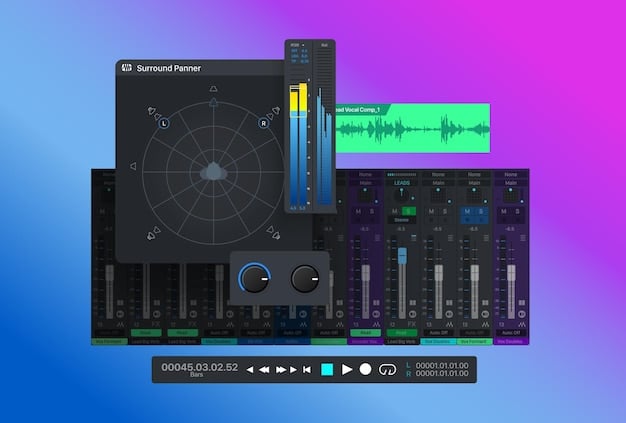Podcast Analytics: Key Metrics to Optimize Your Strategy by 2025

Optimizing podcast content strategy by 2025 hinges on a deep understanding and proactive tracking of key analytics, providing data-driven insights to enhance listener engagement and overall reach.
In the dynamic realm of audio content, understanding your audience is paramount. Podcast Analytics: Tracking Key Metrics to Optimize Your Content Strategy in 2025 is not just a buzzword, it’s the compass guiding creators through an increasingly competitive landscape, ensuring their message resonates powerfully and effectively.
The Evolving Landscape of Podcast Analytics
The podcast industry has matured significantly, moving beyond simple download counts. In 2025, podcast analytics have evolved into a sophisticated toolkit, offering nuanced insights into listener behavior, content performance, and strategic growth opportunities. Understanding this evolution is crucial for any podcaster aiming to optimize their content and expand their reach.
This shift from basic metrics to advanced analytics reflects the industry’s need for more actionable data. Creators are no longer content with knowing merely how many people downloaded an episode; they seek details on who these listeners are, how they engage, and what keeps them coming back. This granular data empowers better decision-making.
Beyond Downloads: A Deeper Dive
While downloads remain a fundamental metric, their significance is now contextualized by a broader array of data points. A high download count is impressive, but without understanding completion rates or demographic breakdowns, it tells an incomplete story. The real value lies in connecting these dots to paint a comprehensive picture of listener interaction.
- Consumption Patterns: How listeners consume content, including device usage and listening environments.
- Audience Segmentation: Breaking down the audience by demographics, interests, and geographic location.
- Engagement Signals: Identifying moments of peak listener attention or drop-off within an episode.
The ability to integrate data from various platforms is also a game-changer. Aggregating analytics from hosting providers, third-party listening apps, and social media creates a holistic view that standalone metrics cannot offer. This integrated approach allows for more precise content adjustments and marketing efforts.
The Role of AI and Predictive Analytics
Looking ahead to 2025, artificial intelligence is set to play an even more significant role in podcast analytics. AI-driven tools can process vast amounts of data to identify trends, predict listener preferences, and even suggest content topics. This predictive capability helps podcasters stay ahead of the curve, crafting content that anticipates audience desires.
Furthermore, AI can automate the identification of conversational patterns, sentiment analysis, and the effectiveness of calls to action within episodes. This level of automated insight frees up creators to focus more on content production and less on manual data crunching, enhancing efficiency and creativity.
The evolving landscape of podcast analytics in 2025 emphasizes precision and proactivity. Creators who embrace these advanced tools will be better equipped to understand their audience, refine their content strategy, and ultimately achieve sustainable growth in a competitive digital audio ecosystem.
Key Metrics and How to Interpret Them
Navigating the world of podcast analytics requires more than just access to data; it demands an understanding of what each metric truly signifies and how to leverage it for strategic advantage. In 2025, certain key metrics stand out as indispensable for optimizing your podcast’s performance and ensuring your content resonates effectively with your target audience.
Interpreting these metrics correctly is paramount. A single data point rarely tells the whole story; it’s the combination and context of various metrics that reveal actionable insights, guiding your content creation and marketing decisions.
Understanding Listener Engagement
Engagement goes far beyond simply starting an episode. It delves into how listeners interact with your content, indicating their level of interest and connection. Metrics such as average consumption time and completion rate offer direct insights into the stickiness of your audio. High completion rates suggest captivating content, while significant drop-offs might signal where listener interest wanes.
- Average Consumption: The typical duration listeners engage with an episode before stopping.
- Completion Rate: The percentage of listeners who listen to an episode from start to finish.
- Repeat Listeners: The number of unique listeners who return for subsequent episodes, indicating loyalty.
Monitoring these metrics episode by episode can highlight specific content elements or segments that perform exceptionally well or, conversely, those that lead to listener fatigue. This allows for iterative improvements, refining your storytelling, segment pacing, and overall production quality.
Audience Demographics and Geographics
Knowing who your listeners are and where they are located is invaluable for targeted marketing and content localization. Demographic data—age, gender, interests—helps in crafting listener personas and understanding their preferences outside of your podcast. Geographic data, on the other hand, can inform advertising placements or even content themes relevant to specific regions.
This information also plays a crucial role in attracting advertisers. Brands are increasingly looking for specific audience segments, and the more detailed you can be about your listenership, the more appealing your podcast becomes as a marketing platform. Utilize listener surveys and integrate data from social media insights to enrich this understanding.

Traffic Sources and Discovery
Understanding where your listeners come from—whether it’s direct searches, third-party apps, social media, or other podcasts—sheds light on your most effective marketing channels. This metric is vital for optimizing your distribution strategy and focusing your promotional efforts where they yield the best results.
Pay close attention to referrals from specific platforms or websites. A surge in listeners from a particular social media campaign or a featured spot on a podcast discovery app indicates a successful outreach effort. Conversely, a lack of traffic from an anticipated source might prompt a re-evaluation of that channel’s effectiveness.
By diligently tracking and interpreting these key metrics, podcasters can transform raw data into a powerful strategic asset. This data-driven approach ensures that content creation is not just an artistic endeavor but a finely tuned process aimed at maximizing audience connection and growth.
Leveraging Analytics for Content Optimization
Once you’ve gathered and interpreted your podcast analytics, the next critical step is to translate these insights into actionable strategies for content optimization. In 2025, the most successful podcasters aren’t just measuring; they’re actively adapting their content based on empirical data, ensuring every episode delivers maximum value and engagement to their audience.
Content optimization through analytics is an iterative process. It involves making informed adjustments to your topics, format, length, and even your messaging based on how your audience responds, fostering a continuous cycle of improvement and growth.
Refining Topics and Themes
Listener engagement metrics, particularly average consumption and drop-off rates, are goldmines for topic optimization. If episodes on certain themes consistently boast higher completion rates, it’s a clear signal that your audience is highly interested in those subjects. Conversely, episodes with low engagement might suggest topics that don’t resonate as strongly.
Additionally, monitoring search terms and audience feedback from social media or direct messages can provide direct input on what your listeners want to hear more about. Use this qualitative data in conjunction with quantitative analytics to brainstorm new episode ideas that are guaranteed to capture attention and maintain engagement.
Adjusting Episode Length and Format
The “ideal” podcast length is a perennial debate, but your analytics can provide a definitive answer for your specific audience. Analyze average consumption times across various episode lengths. If shorter episodes consistently have higher completion rates, it might indicate your audience prefers concise content. Conversely, if longer, in-depth discussions retain listeners, you might have an audience that appreciates a deeper dive.
Similarly, experiment with different formats—interviews, solo monologues, narrative storytelling, Q&A segments—and observe which formats drive the highest engagement. Some audiences thrive on dynamic conversations, while others prefer deeply researched solo presentations.
- Episode Structure: Experiment with segment ordering and pacing to identify listener sweet spots.
- Sound Design: Analyze how intro/outro music and sound effects impact listener retention.
- Call to Action Placement: Test different placements of CTAs to see which yield the best conversion rates.
Enhancing Listener Experience
Beyond content, analytics can inform improvements to the overall listener experience. For instance, if data shows a significant drop-off at specific timestamps, it might indicate issues with audio quality, a slow segment, or an unengaging transition. Addressing these technical or pacing issues can dramatically improve listener retention.
Furthermore, understanding device usage (mobile vs. desktop) and listening environments (commuting vs. at home) can influence your production choices, such as optimizing audio for different speaker types or ensuring clarity in noisy environments. By obsessively focusing on the listener’s journey from discovery to completion, podcasters can cultivate a loyal and expanding audience.
Ultimately, leveraging analytics for content optimization transforms guesswork into informed strategy. It allows podcasters to continually refine their craft, ensuring their content not only reaches but also deeply connects with their intended audience, fostering sustained growth towards 2025.
Tools and Platforms for Advanced Analytics in 2025
In the rapidly evolving podcasting landscape of 2025, relying solely on basic download numbers is akin to navigating with a blindfold on. The availability of advanced analytics tools and platforms has revolutionized how podcasters understand their audience and optimize their content. Choosing the right tools is paramount for gaining a competitive edge and making data-driven decisions.
These platforms offer a spectrum of features, from granular listener demographics to sophisticated engagement mapping, allowing creators to move beyond surface-level insights and dive deep into listener behavior.
Native Hosting Platform Analytics
Most reputable podcast hosting platforms now offer robust native analytics dashboards. These are often the first and most accessible sources of data for podcasters, providing essential metrics such as total downloads, unique listeners, geographical distribution, and device usage. Platforms like Libsyn, Buzzsprout, Acast, and Anchor (Spotify for Podcasters) have continuously enhanced their analytical capabilities.
- Libsyn: Known for detailed download statistics and IAB certified metrics.
- Buzzsprout: Offers visual listener stats, including geographic breakdowns and podcast app data.
- Acast: Provides advanced demographic insights and brand-specific attribution reporting for advertisers.
- Spotify for Podcasters: Unique in offering Spotify-specific audience demographics and listener retention data.
While native analytics provide a solid foundation, their scope can sometimes be limited to data generated within their ecosystem. For a truly comprehensive view, integrating with third-party tools is often necessary.
Third-Party Analytics and Attribution Tools
Beyond hosting platforms, a growing number of specialized analytics and attribution tools offer deeper, cross-platform insights. These tools excel at aggregating data from various sources, providing a unified dashboard, and often employing advanced methodologies to track listener journeys and advertising effectiveness.
Companies like Chartable and Podsights (now part of Spotify) have become industry standards for their ability to provide sophisticated attribution models, allowing podcasters and advertisers to precisely measure the impact of their marketing campaigns. These tools can track listens that originate from specific promotional codes, URLs, or even audio ads, offering invaluable ROI data.

AI-Powered Analytics and Predictive Modeling
The frontier of podcast analytics in 2025 is increasingly shaped by artificial intelligence and machine learning. AI-powered platforms can analyze spoken content, identify trends, predict listener behavior, and even suggest optimal release times or content themes. Tools leveraging natural language processing (NLP) can transcribe episodes and perform sentiment analysis, identifying segments that resonate positively or negatively with listeners.
This predictive capability helps podcasters proactively adapt their strategy rather than reactively responding to past performance. Imagine an AI tool suggesting a specific guest or topic based on what your audience demographics are currently engaging with across the wider internet, or predicting optimal promotion channels based on past listener acquisition patterns.
Investing in the right mix of native, third-party, and AI-powered analytics tools is not just an expense; it’s an investment in the future of your podcast. These platforms provide the granular data and predictive insights necessary to continually optimize your content strategy, maximize listener engagement, and achieve sustainable growth in the competitive audio landscape.
Strategies for Data-Driven Growth and Monetization
In 2025, the true power of podcast analytics extends beyond mere content optimization; it directly fuels data-driven growth and monetization strategies. Understanding your listener base and their behavior opens doors to more effective marketing, enhanced listener retention, and diverse revenue streams. Neglecting these insights means leaving potential growth and income on the table.
A data-informed approach transforms guesswork into strategic planning, ensuring every effort contributes to expanding your reach and maximizing your podcast’s financial viability.
Targeted Marketing and Audience Acquisition
Analytics allows for highly targeted marketing campaigns, reducing wasted resources and increasing acquisition efficiency. By understanding the demographics, interests, and discovery paths of your existing listeners, you can identify look-alike audiences on social media and other platforms, directing your promotional efforts precisely where they’re most likely to yield new subscribers.
For instance, if your data shows a high concentration of listeners in a particular age group who primarily consume content via a specific app, you can tailor your advertising on that platform to appeal directly to that demographic, using language and visual styles that resonate with them. This precision marketing is far more effective than broad-stroke advertising.
- Platform-Specific Promotion: Tailoring promotional content to the nuances of each social media or podcast platform.
- Cross-Promotion Opportunities: Identifying podcasts with overlapping but not identical audiences for collaborative episodes.
- Listener Persona Development: Creating detailed profiles of ideal listeners to guide all marketing and content decisions.
Enhancing Listener Retention and Loyalty
Acquiring new listeners is one thing; retaining them is another, and analytics are crucial for fostering loyalty. By tracking metrics like repeat listeners and episode completion rates over time, you can gauge the effectiveness of your retention strategies. If listener churn is high after a particular episode type, it’s an immediate signal to re-evaluate that content approach.
Engagement data also informs community building. Understanding which segments or topics generate the most discussion allows you to create more interactive content, like Q&A episodes or live streams, directly addressing listener questions and fostering a deeper connection. A loyal listener base is your most valuable asset.
Optimizing Monetization Opportunities
Data is central to successful podcast monetization in 2025. For advertising, granular audience data and detailed performance metrics are what attract premium sponsors. Advertisers want to know the precise reach, engagement, and demographic profile of your listenership to justify their investment.
Beyond traditional advertising, analytics can reveal other monetization avenues. If your audience metrics show a strong, engaged core of listeners, that might indicate potential for direct listener support through platforms like Patreon, premium content subscriptions, or merchandise sales. Understanding their purchasing power and loyalty helps in setting pricing and content offerings.
Furthermore, A/B testing different ad placements, call-to-action phrasing, or sponsorship segments based on conversion analytics can significantly boost revenue from existing advertising partnerships. Similarly, tracking conversions from affiliate links mentioned in episodes provides direct feedback on product relevance and audience interest.
By leveraging analytics strategically for growth and monetization, podcasters can transform their passion into a sustainable and profitable venture, ensuring long-term success in the dynamic audio content industry.
Challenges and Best Practices in Podcast Analytics
While the benefits of podcast analytics are undeniable, navigating the landscape of data collection, interpretation, and privacy presents its own set of challenges. In 2025, podcasters must be aware of these hurdles and implement best practices to ensure their analytical efforts are both effective and ethical. Overcoming these challenges is crucial for building trust and maintaining a healthy relationship with your audience.
The complexities range from fragmented data sources to evolving privacy regulations, demanding a proactive and informed approach from content creators.
Data Fragmentation and Standardization
One of the persistent challenges in podcast analytics is data fragmentation. Listeners consume podcasts across a multitude of apps and platforms, each providing its own set of metrics, often with varying definitions or reporting methodologies. Aggregating and normalizing this data to get a consistent, unified view can be a significant hurdle, especially for independent podcasters without advanced tools.
The industry is slowly moving towards greater standardization, with initiatives like IAB Podcast Measurement Guidelines providing a common framework for reporting. However, fully consistent, cross-platform metrics remain an aspiration. Podcasters should prioritize hosting providers and analytics tools that adhere to these standards where possible to ensure data comparability.
Privacy Concerns and Data Ethics
As data collection becomes more sophisticated, so do concerns about listener privacy. Regulations like GDPR and CCPA are shaping how audience data can be collected, stored, and utilized. Podcasters must be transparent with their audience about data practices and ensure compliance to avoid legal repercussions and maintain listener trust.
Ethical data usage involves not just compliance but also respect for privacy. This means anonymizing data where possible, avoiding over-collection, and using data primarily to enhance the listener experience rather than for intrusive targeting. Building a reputation for data ethics can solidify listener loyalty in the long run.
Avoiding Analysis Paralysis and Vanity Metrics
The sheer volume of data available can sometimes lead to “analysis paralysis”—spending too much time interpreting data without taking action. It’s crucial to identify the key, actionable metrics that directly impact your goals, rather than getting bogged down in every single data point. Not all metrics are created equal; some are “vanity metrics” that look good but offer little strategic value.
For example, while total downloads are important, focusing solely on them without considering completion rates or audience demographics can be misleading. A massive download count means little if listeners drop off within the first few minutes of every episode. Prioritize metrics that inform specific content or marketing decisions.
Best Practices for Data Utilization
To effectively leverage podcast analytics, adopt a systematic approach:
- Define Clear Objectives: Before diving into data, know what you want to achieve (e.g., increase completion rate by 10%, attract more listeners from a specific demographic).
- Regular Review: Schedule consistent times to review your analytics, allowing for timely adjustments to your strategy.
- A/B Testing: Experiment with different episode lengths, formats, and promotional tactics, and use data to determine what works best.
- Segment Your Audience: Break down your audience data into meaningful segments to understand different listener behaviors.
- Integrate Widespread Feedback: Combine quantitative analytics with qualitative feedback from surveys, social media comments, and direct messages.
By consciously addressing these challenges and adhering to best practices, podcasters can transform analytics from a complex chore into a powerful, insightful tool that drives continuous improvement and sustained success in 2025.
The Future of Podcast Analytics: 2025 and Beyond
As we look towards 2025 and beyond, the landscape of podcast analytics is poised for even greater transformation. The convergence of advanced AI, enhanced data privacy frameworks, and the increasing sophistication of listener behavior tracking will redefine how podcasters measure success and connect with their audience. Understanding these emerging trends is key for creators preparing for the next wave of audio innovation.
The future promises a more personalized, precise, and proactive approach to understanding podcast engagement, moving further into predictive and prescriptive analytics.
Hyper-Personalized Listener Journeys
Future analytics will focus more on individual listener journeys rather than just aggregated data. Imagine tools that can identify unique listening patterns for each subscriber, suggesting personalized content recommendations not just for them but also predicting what types of content would retain them longer. This level of hyper-personalization, driven by AI and machine learning, will make content creation increasingly audience-centric.
This includes analyzing factors like preferred listening times, device-switching habits, and genre preferences across various audio platforms. The goal is to move from understanding “the average listener” to comprehending “each specific listener” for ultimate content relevance.
Advanced Content and Ad Attribution
The challenge of cross-platform attribution for both content discovery and advertising effectiveness will see significant advancements. Technologies will emerge that more accurately track a listener’s journey from their first exposure to a podcast (through an ad, social post, or recommendation) to their continued engagement and conversions. This will provide unprecedented clarity for both podcasters and advertisers on true ROI.
Attribution models will move beyond last-touch to multi-touch attribution, giving credit to every touchpoint in the listener’s journey, from initial discovery to conversion. This will inform more sophisticated marketing spend and content placement decisions.
Predictive Analytics and Content Generation
Further integration of AI means not just reporting on what happened, but predicting what will happen. Predictive analytics will become commonplace, offering insights into future listener behavior, potential content trends, and optimal release schedules. Some tools might even assist in content generation, suggesting specific script elements or interview questions based on predicted audience interest.
This predictive capability will empower podcasters to become proactive rather than reactive, making strategic decisions based on forecasted trends and audience needs before they are fully apparent. This allows for staying ahead in a competitive market.
Enhanced Data Privacy and Ethical AI
While data collection capabilities expand, so will the emphasis on robust data privacy. Future analytics solutions will likely incorporate privacy-by-design principles, ensuring listener data is handled ethically and transparently from the outset. This could involve more widespread use of differential privacy and federated learning to gain insights without compromising individual user information.
Ethical AI will also be a critical concern, ensuring that algorithms are unbiased and do not perpetuate harmful stereotypes in content recommendations or audience segmentation. Trust will be a cornerstone of data-driven growth in the audio space.
The future of podcast analytics in 2025 and beyond points towards a more intelligent, integrated, and responsible approach to data. Podcasters who embrace these advancements will not only understand their audience better but will also build more sustainable and impactful audio brands in the long term.
Optimizing Your Episode Release Strategy with Analytics
An often-overlooked aspect of podcast optimization is the release strategy. It’s not just about creating great content but also about delivering it at the right time and with the right cadence. In 2025, sophisticated analytics empower podcasters to fine-tune their episode release strategy, maximizing immediate reach and long-term engagement. This data-driven approach moves beyond anecdotal evidence to concrete listener behavior patterns.
Optimizing this aspect involves understanding listener habits, platform algorithms, and the impact of consistency on audience retention. It’s about ensuring your content lands squarely within your audience’s prime listening window.
Understanding Listener Peak Times
Your analytics dashboard likely provides data on when your listeners are most active. This might vary significantly based on your target demographic, their geographic location, and their daily routines. For example, a podcast targeting commuters might see a peak in listens during morning and evening rush hours, while a leisure-focused podcast might see peaks on weekends or during evenings.
By identifying these peak listening times, you can schedule your episode releases to coincide with when your audience is most likely to hit play. This immediate availability during high-traffic periods can significantly boost initial download numbers and get your episode trending within listening apps, leading to greater discoverability.
- Geographic Time Zones: Adjusting release times to cater to your primary audience’s time zones.
- Day-of-Week Performance: Identifying which days yield the highest engagement for your content.
- Listener Routine Integration: Aligning releases with common daily schedules (e.g., lunch breaks, commutes).
Cadence and Consistency
Analytics can also help determine the optimal release cadence for your podcast—weekly, bi-weekly, monthly, or irregular. While consistency is generally hailed as key for audience loyalty, the exact frequency should ideally be data-informed. If your analytics show a significant drop-off in activity or higher churn rates when you extend gaps between episodes, it might indicate that your audience prefers a more frequent release schedule.
Conversely, if producing weekly content leads to a decline in quality or burning out your production team, and your audience metrics don’t significantly suffer with a bi-weekly schedule, that insights suggest a more sustainable pace. It’s about finding the sweet spot where quality meets consistent delivery and audience expectation.
Impact on Discoverability and Algorithms
Podcast platforms and apps often favor consistent content creators. Regular releases can signal to algorithms that your podcast is active and engaging, potentially boosting its visibility in recommendations and search results. Analytics can track how changes in your release schedule impact your new listener acquisition rates and overall algorithmic favorability.
For instance, if a consistent weekly release leads to a steady increase in new subscribers and higher chart rankings, it’s a strong indicator that the algorithm is rewarding your regularity. Conversely, sporadic releases might see your podcast’s visibility drop off, as algorithms prioritize fresh and active content.
By meticulously leveraging analytics to inform your episode release strategy, podcasters can ensure their valuable content not only gets produced but also gets consumed by the widest possible audience at the most impactful times, driving sustained growth and engagement into 2025 and beyond.
| Key Metric | Brief Description |
|---|---|
| 📊 Completion Rate | Percentage of listeners finishing an episode, indicating content engagement. |
| 📍 Geographic Data | Listener locations, useful for targeted marketing and content localization. |
| 📈 Traffic Sources | Where listeners discover your podcast, optimizing distribution strategies. |
| 🔄 Repeat Listeners | Measures audience loyalty and content retention effectiveness. |
Frequently Asked Questions about Podcast Analytics
▼
Podcast analytics refers to the collection and analysis of data related to podcast listenership and performance. In 2025, it’s crucial because it provides actionable insights into audience behavior, guiding content optimization, marketing efforts, and monetization strategies for sustainable growth in a competitive market.
▼
Key metrics include episode downloads, unique listeners, listener demographics (age, gender, location), average consumption time, completion rate, and traffic sources. Tracking these metrics offers a holistic view of your audience’s engagement and helps pinpoint areas for improvement in content and promotion.
▼
Analytics can help you refine episode topics and length by identifying what keeps listeners engaged. High completion rates for certain themes or formats signal what resonates. Drop-off points indicate where attention wanes, prompting adjustments in pacing, sound quality, or content structure to enhance the listener experience.
▼
Yes, as with any data collection, privacy is a significant concern. Podcasters must adhere to regulations like GDPR and CCPA, be transparent with listeners about data usage, and prioritize ethical data handling. Using anonymized data where possible and focusing on aggregated insights helps maintain listener trust while enabling effective analysis.
▼
Looking ahead, future trends in podcast analytics include hyper-personalized listener journey mapping, advanced AI-powered content and ad attribution, predictive analytics for content generation and trend forecasting, and an increased focus on ethical AI and robust data privacy frameworks to ensure responsible data utilization.
Conclusion
In conclusion, the strategic application of Podcast Analytics: Tracking Key Metrics to Optimize Your Content Strategy in 2025 is no longer just beneficial but essential for any serious podcaster. By meticulously analyzing listener behavior, understanding audience demographics, and leveraging advanced tools, creators can transform raw data into actionable insights. This data-driven approach fosters continuous content refinement, enables highly targeted marketing, and unlocks diverse monetization opportunities, ensuring your podcast not only survives but thrives in the competitive and ever-evolving audio landscape of today and tomorrow. Embracing analytics empowers you to build a stronger connection with your audience and achieve sustainable growth.





